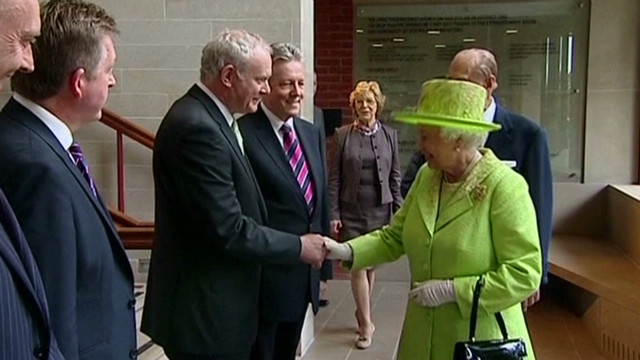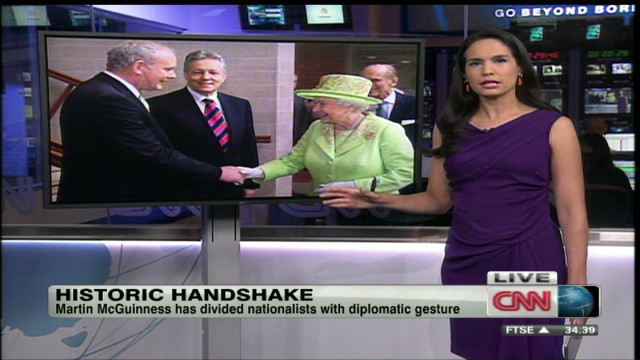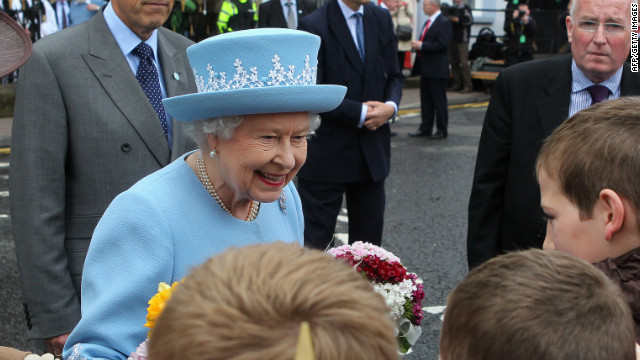Story highlights
- Sinn Fein leader Gerry Adams says it is "a good day for Ireland"
- Martin McGuinness speaks of the need to acknowledge the pain of all victims
- Queen Elizabeth II lost a relative, Lord Mountbatten, to an IRA bomb in 1979
- The meeting would have been unthinkable a decade ago
Britain's Queen Elizabeth II shook hands Wednesday with former IRA commander Martin McGuinness in a historic gesture marking a giant step forward in the peace process relating to British rule of Northern Ireland.
The handshake came 14 years after the end of a conflict that claimed about 3,500 lives, including that of the queen's cousin Lord Louis Mountbatten in an IRA bombing.
McGuinness spoke to the queen in Irish as they clasped hands and made eye contact for several seconds in the ground-breaking public part of the event.
"Goodbye and godspeed," McGuinness said, translating his comment for the queen. She smiled throughout the encounter but did not speak.
The handshake followed a brief private meeting at which McGuinness told the queen their meeting was a powerful signal that peace-building requires leadership, his party, Sinn Fein, said.
He emphasized the need to acknowledge the pain of all victims of the conflict and their families, Sinn Fein said.
Queen Elizabeth wore green for the meeting, which observers saw as a subtle outreach to Irish nationalists, whose color is green.
"It went good, it went really well," McGuinness said afterwards, adding he is "still a republican" who opposes British rule of Northern Ireland.
Sinn Fein president Gerry Adams welcomed what he called a "historic meeting," saying that "all in all, it's a good day for Ireland and a good day for the people of these islands."
Speaking outside the Irish parliament, he said: "It brings our journey of relationship building within this island and between these islands onto a new plane. I would like to think we will build upon that."
Adams said some issues remained to be resolved, particularly the legacy of the conflict and the need for the relatives of those killed by British armed forces to have the facts investigated by an inquiry.
But, he said, he believes the vast majority of unionists would be pleased that it was a "real gesture beyond the rhetoric towards their sense of identity and their sense of allegiance."
The organizer of the event called the handshake "a significant milestone on the road to reconciliation on this island and between our two islands."
Peter Sheridan, the chief executive of Co-operation Ireland, said he was struck by "the ordinariness of the handshake by people who are in no way ordinary."
McGuinness has been a key player in ending the conflict between pro- and anti-British forces in Northern Ireland. Unionists want the province to remain under British control, while republicans want it to join the Republic of Ireland.
Three decades of violence over the question largely came to an end with the Good Friday peace deal in 1998.
The violent period known locally as The Troubles was marked by a full-scale British military presence in the province and deadly bombings and shootings in Northern Ireland and Britain.
Unionists and republicans committed terrible violence against each other and against perceived traitors in their own ranks. A handful of people who disappeared during the Troubles have never been found.
The queen arrived in Northern Ireland on Tuesday for a two-day visit marking her Diamond Jubilee, 60 years on the throne.
She met McGuinness, now the deputy first minister of Northern Ireland, at an arts event in Belfast. Irish President Michael Higgins also attended the event.
There were clashes between police and demonstrators late Tuesday night ahead of the visit, police said.
Nine officers sustained "minor injuries" when they were attacked with "missiles including 21 petrol bombs" from a crowd of about 100 people, police said.
There were also scuffles between pro- and anti-British groups in Belfast Tuesday night over an Irish flag put up on a mountain overlooking the city in protest of the Queen's visit, the Police Service of Northern Ireland said Wednesday.
On Tuesday, the queen was greeted in Enniskillen -- the scene of a deadly IRA bombing in 1987 -- by crowds lining the streets and waving Union flags.
She was greeted by Secretary of State for Northern Ireland Owen Paterson, who accompanied her to a jubilee thanksgiving service at St. Macartin's Cathedral, an Anglican church, that was attended by more than 700 people.
She also went to a smaller service at St. Michael's Church in Enniskillen, a Catholic church.
Friday's confirmation that the queen would meet McGuinness prompted wide reaction in the British media.
The trip follows the queen's visit to the Republic of Ireland in May of last year, which was seen as ushering in a new era in relations.
The meeting has an added significance for the queen because of the killing of Lord Mountbatten. IRA members have also killed police officers and soldiers in Northern Ireland, who serve in the queen's name.
The nationalist community in Northern Ireland sees the British as occupiers and wants their rule in the province to end.
Sinn Fein is the leading republican political party in Northern Ireland, and was widely assumed during the conflict to be the political wing of the militant IRA.
Adams said last week that Irish republicans have often been prepared to take bold initiatives in pursuit of peace.
In his remarks Wednesday, he said: "Ireland is changing; it's changing because of the peace process, it's changing because of all the revelations of sleaze and scandals and corruption in this state, and it's changing because of the economic crisis.
"So people know we deserve a better society and republicans, like everyone else who thinks about the future and thinks about Ireland, want to be part of shaping that out, and the unionists are a very essential part of that equation."
The Queen's 2011 visit to Ireland was the first by a British monarch to the republic since it gained independence in 1921 and marked a reconciliation between neighboring countries, which once viewed each other with suspicion and hostility.
McGuinness has admitted that he was a leader of the Provisional IRA during the 30-year conflict in Northern Ireland between pro-British and pro-Irish forces.
In recent years, he has received death threats from hard-line dissident IRA splinter groups because of his support for the peace process.
The majority of the island gained independence in 1921, following two years of conflict. But six of the nine counties of the province of Ulster chose to stay in the United Kingdom, eventually becoming the country of Northern Ireland.
In the late 1960s, the conflict between mainly Protestant unionists, who want Northern Ireland to remain part of the United Kingdom, and largely Roman Catholic nationalists, who want it to be reunited with the rest of Ireland, exploded into a political and sectarian war, known as the Troubles.
The three decades of ensuing violence between the IRA and loyalists claimed the lives of more than 3,000 people, most of them north of the border, and while the Good Friday Agreement of 1998 effectively ended the conflict, suspicions remain.
Under the terms of the landmark accord, terrorist groups on both sides dumped their weapons, and their political affiliates now work together in Northern Ireland's power-sharing government.





































